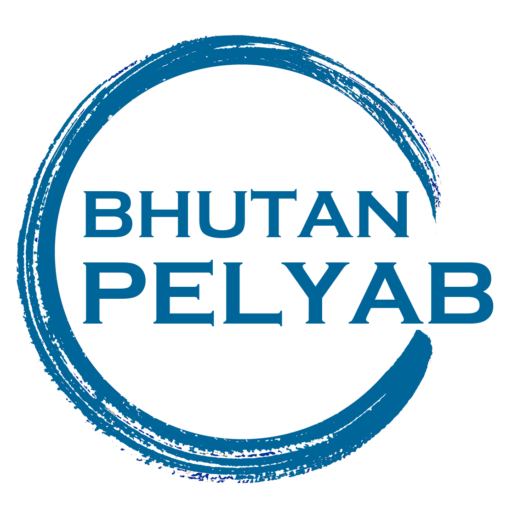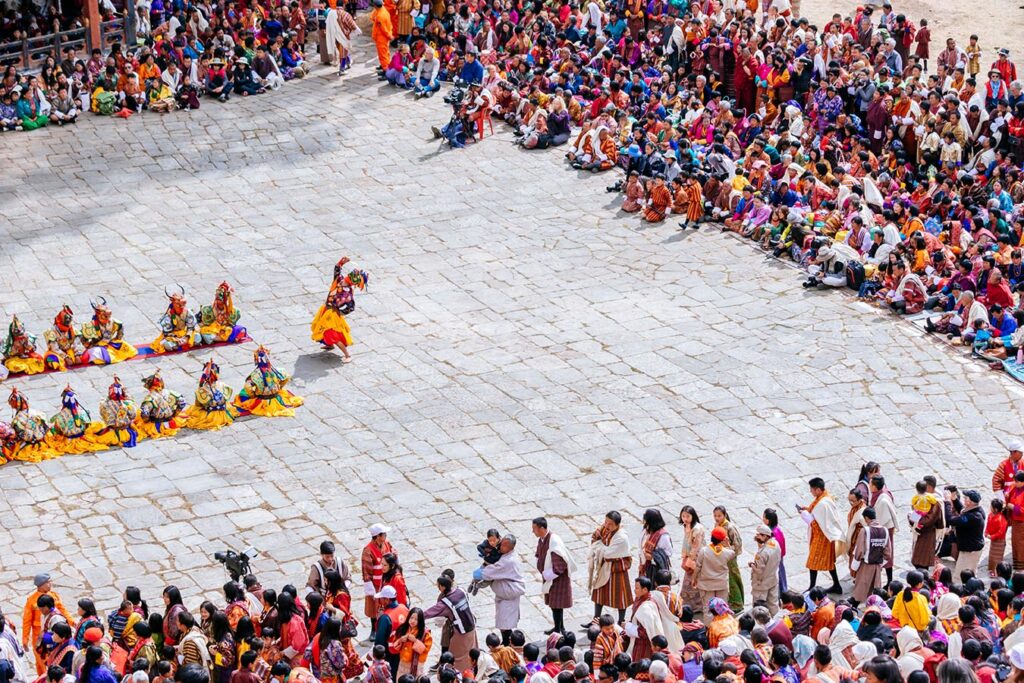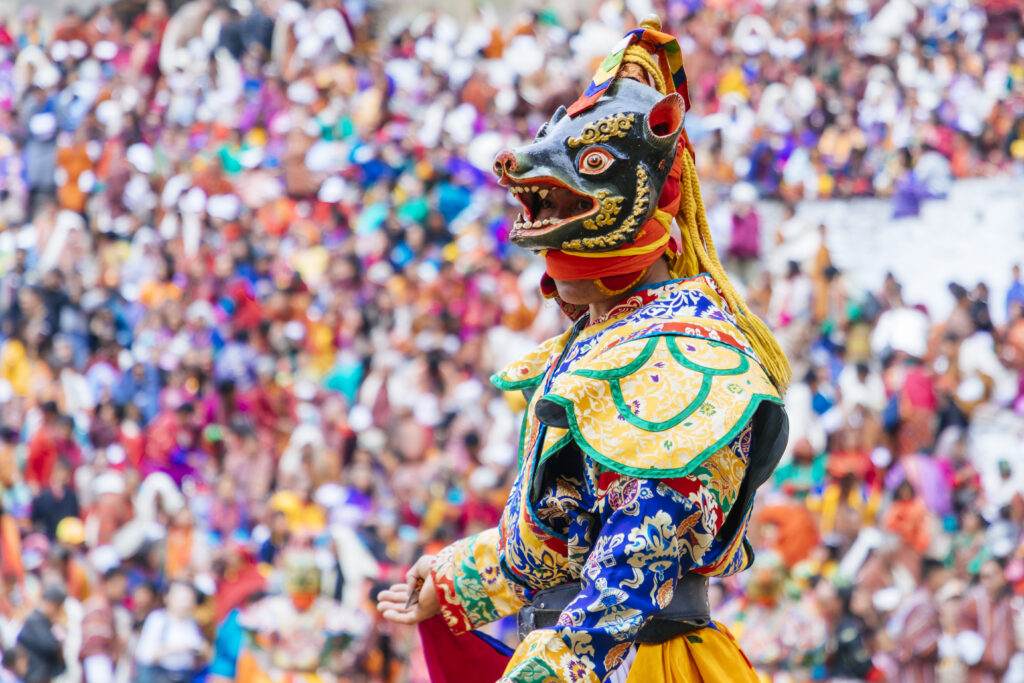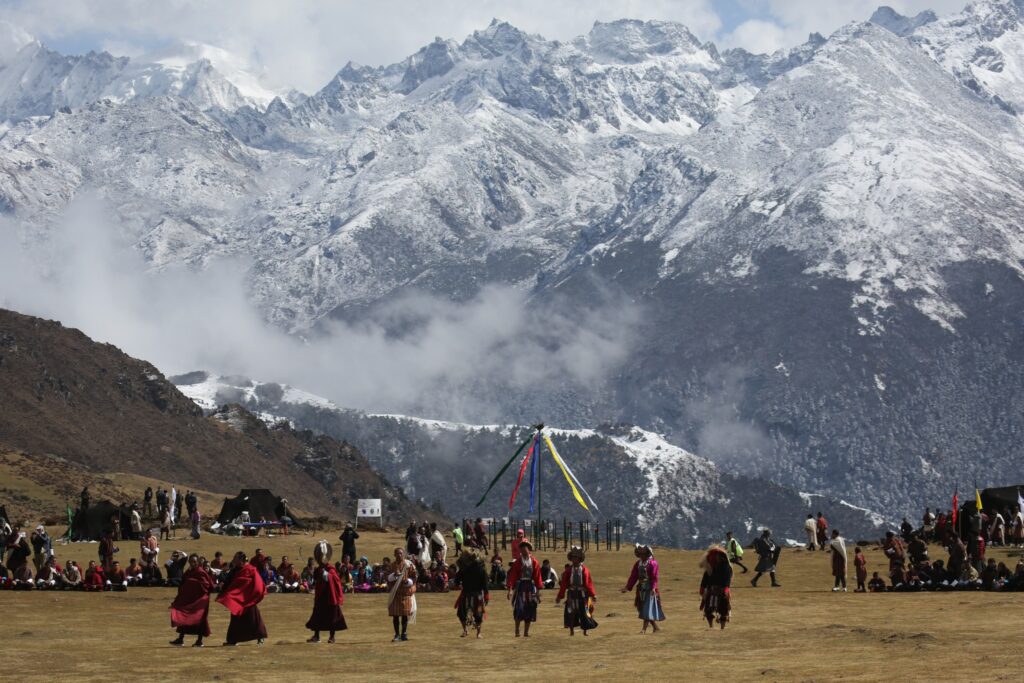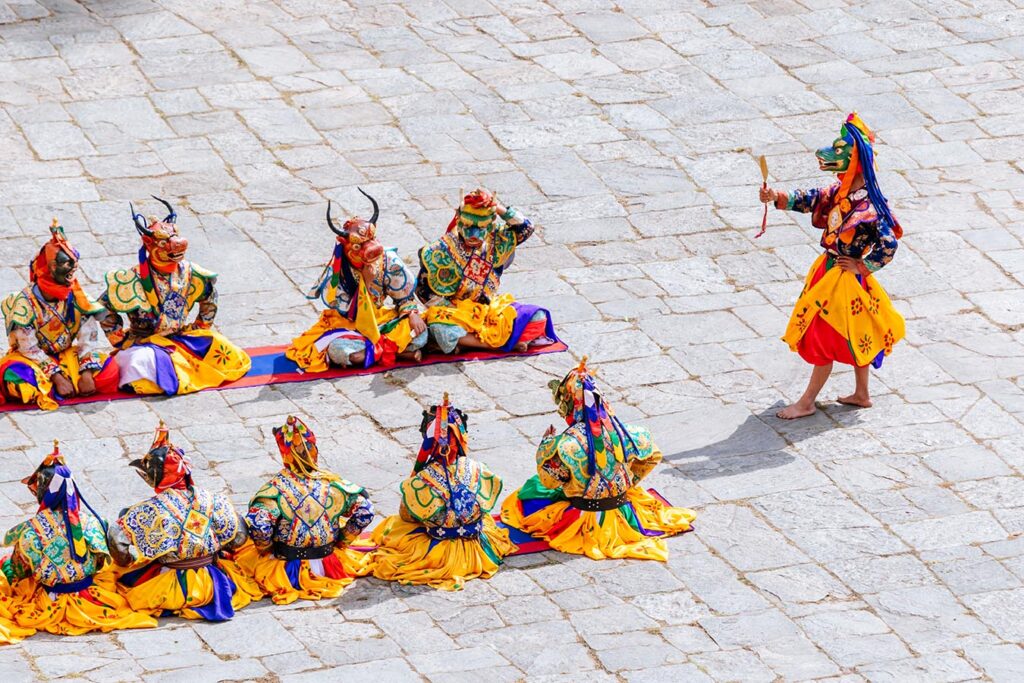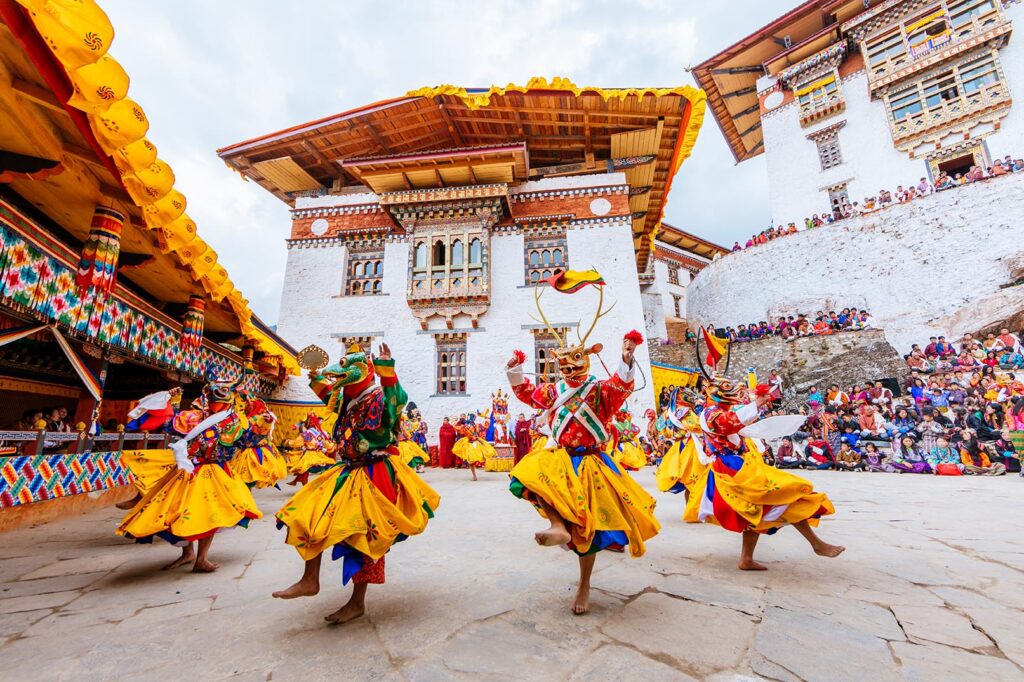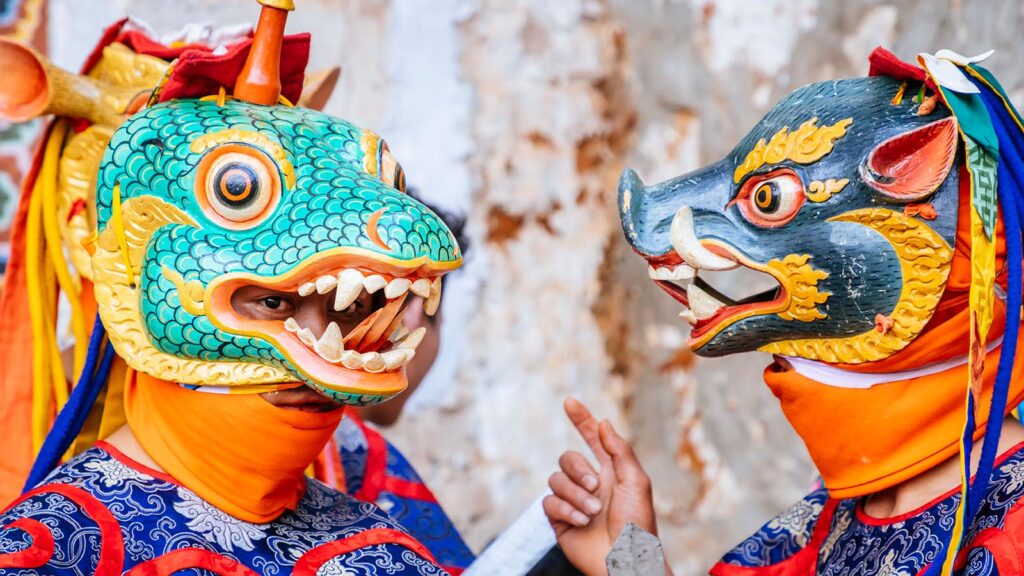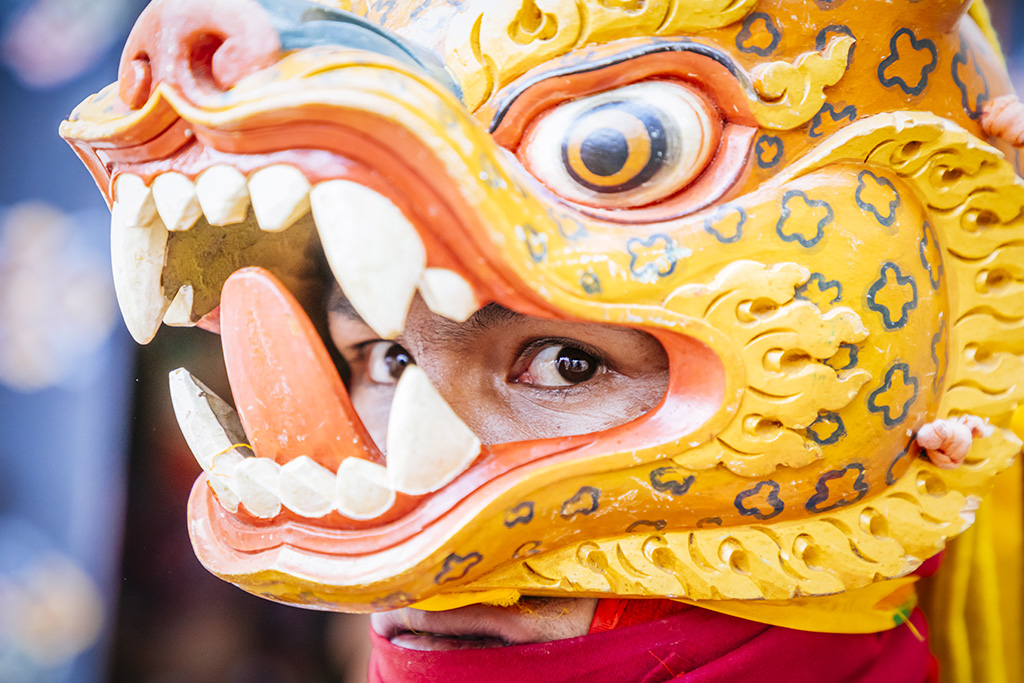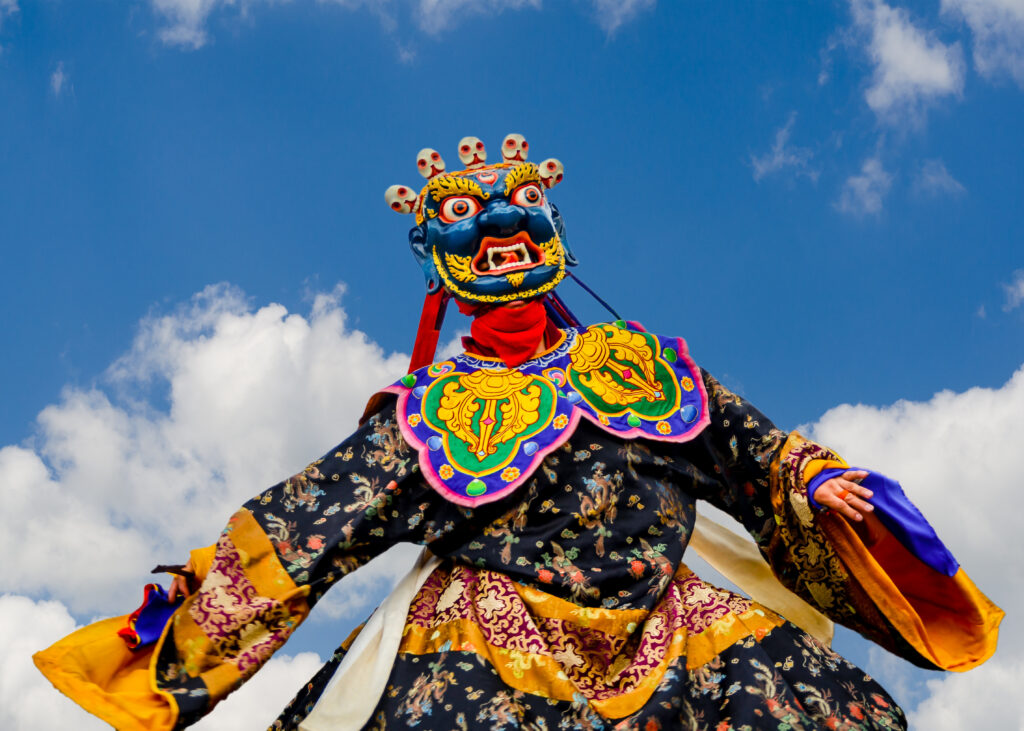Day 01: Arrive in Paro and travel to Thimphu
- Altitude in Paro: 2,300m
- Altitude in Thimphu: 2,400m
- Distance: 55km
- Estimated travel time: 1.30hrs
The first sight you will see from your plane window upon landing in Paro is the snowcapped mountains of the Himalayas. Our representative will welcome you and then drive you to Thimphu, Bhutan’s capital.
Along the way, we will pay a visit to the beautiful Tachogang Lhakhang (Temple of The Excellent Horse). It was the work of the great Bhutanese bridge builder Thangtong Gyalpo (1385-1464).
The first thing you will notice in Thimphu is the juxtaposition of ancient tradition and modernity, where one can explore historic sites and then relax in a pub or bar. We will have a short break before heading to see the National Memorial Chorten, a renowned religious landmark of Thimphu. It was built to dedicate to world peace and prosperity, but later also became a monument for the Late Third King, His Majesty Jigme Dorji Wangchuk.
After that, we will go up to a hilltop to visit the tallest Buddha statue in Bhutan – Buddha Point (Buddha Dordenma Statue). The 51.5m is believed to fulfill a prophecy from the 8th century A.D to prevent a war from happening. Because of its location on top of the hill, this is a great location to catch the view of entire Thimphu town.
Thimphu is otherwise known for its dynamic life. We will wander around the main street Norzin Lam, from souvenirs, woolen clothes to local wine, all can be found here. Nightclubs are also a cool place to enjoy live music and good cocktails in Thimphu.
We will stay overnight at the hotel in Thimphu.
Day 02: Discover Thimphu
We will visit Tango monastery (2,800m) in the morning. The moderate hike has an elevation gain of 400m. The route will lead through lush forests of blue pine, oak trees, rhododendron, and alpine woods when we go uphill. After about 1 hour, we will reach the monastery.
Tango monastery is a well-known Buddhist learning centre located to the north of Thimphu, and Tango is the highest level which is equivalent with the master degree in academy studies. Many religious leaders — locally known as Je Khenpo —in the country have gone through a nine-year training program at the ancient monastery.
Next, we will have some time for lunch and then go to see Jungshi Handmade Paper Factory, only 1km from the city center of Thimphu. Here you can learn about the exciting traditional methods of producing Dehsho paper, which is made from the bark of two tree species – Daphne and Dhekap tree. Dehsho paper is used to make woodblock and manuscript books and also for writing prayer books.
Later, we will visit the National Institute for Zorig Chusum, commonly known as the ‘Arts And Crafts School’ or the ‘Painting School’. There is no better place to understand more about Bhutan’s traditional arts like seeing the demonstration of these skills. You will have the chance to see young students practicing painting, embroidery or wood-carving and more, each type of art requires a tremendous amount of effort to really master it.
The last destination today is the famous Tashichho Dzong (Fortress of The Glorious Religion). Originally erected in 1216 A.D, the edifice has gone through reconstructions and was completely renovated in 1952 by King Jigme Dorji Wangchuck. The spectacular structure sits on the bank next to Wang Chhu River, and its surrounding is enhanced with well-kept lawns and beautiful gardens. The sight of flag changing ritual at Tashichho Dzong is also very interesting to watch, so make sure you catch it at 5pm!
We will stay for another night at the hotel in Thimphu.
Day 03: Thimphu to Gangtey
- Altitude in Gangtey: 2,900m
- Distance: 160km
- Estimated travel time: 6hrs
Today we will drive to Gangtey valley (also known as ‘Phobjikha valley’), one of the most picturesque regions of Bhutan. On the way, we will first visit Dochula Pass at 3,050m. The pass is visitors’ favourite location for sightseeing, since you will have the breathtaking panoramic view of the Eastern Himalayan ranges from here. The view is even more stunning on clear, winter days with the 108 chortens gracing along the hillside with the majestic snowcapped-mountain backdrop.
After reaching Gangtey, we will explore Gangtey Goemba (or Gangtey monastery), built in 1613. It is the only Nyingmapa monastery in this region, standing on top of a hill overlooking the entire valley. The massive goemba consists of a monastic school and houses the 9th reincarnation of the Gangtey Tulku. This is one of the best places to see the fertile landscape of Gangtey, the winter home of the rare Black-necked Cranes.
We will stay overnight at the hotel in Gangtey.
Day 04: Gangtey to Punakha
- Altitude in Punakha: 1,300m
- Distance: 87km
- Estimated travel time: 3hrs
The journey today will start with a pleasant hike – Gangtey Nature Trail, which will lead us to the most attractive sites of Gangtey valley. From the small hilltop overlooking Gangtey Goemba, we will follow the path down to beautiful flower fields and to Semchubara village. After Semchubara village, the trail will run through forests of blue pines before we walk down to a valley viewpoint and finish at the picturesque Khewang Lhakhang (Khewang temple).
Later, when we travel to Punakha, we will also have time to enjoy a nice walk across hillock fields to Chimi Lhakhang (Temple of Fertility). Childless people go to the temple to pray and receive a wang (blessing or empowerment). The walk is about 25 minutes and we will also pass Lobesa village, where you will see famers working on their fields.
Punakha is the old capital of Bhutan thus it has been inextricably linked with momentous occasions in Bhutanese history. Once we are in Punakha, we will walk up to Khamsum Yuelley Namgyal Chorten, located on a ridge above the valley at an altitude of 1,500m. The walk will lead through rice fields and pine trees and take about 1 hour to get to the chorten. The outstanding building has a unique structure, an example of gorgeous traditions and architecture of Bhutan. The golden spire and labyrinthine wall patterns square is nothing like you will see at other chortens. Also, because of its location on the crest, the chorten offers an incredible view of Punakha valley. Enjoy the view!
Tonight, we will rest at the hotel in Punakha.
Day 05: Punakha Tshechu Festival
Today is the highlight of the whole journey, as we will join in the renowned Punakha Tshechu Festival, held at Punakha Dzong.
The Punakha Dzong, also known as the Palace of Great Happiness, is a stunning fortress in Bhutan. Every year, the famous Tshechu festival takes place here, making it one of the most revered dzongs in the country. It was the second dzong to be built in Bhutan and served as the seat of the government until the early 1950s. The Punakha Dzong sits at the confluence of the Pho Chuu and Mo Chhu rivers and looks like a massive ship floating on water from a distance.
Punakha Tshechu Festival is one of the most celebrated Tshechus in Bhutan. The festival lasts 3 days and will take place on the 10th of the first lunar month. It is dedicated to honour Guru Rinpoche (or Padmasambhawa), the great master who is credited with having brought Tantric Buddhism to the Himalayas.
Throughout the 3 days of the Tshechu, there will be mask dances by the monks as well as songs and dances performed by the locals. The monks, clad in colorful brocade attire, will perform dances while chanting and reading Buddhist scripts. The most awaited event of Punakha Tshechu is the unfurling of Thongdrol (a large tapestry) by Guru Rinpoche. Only seeing the sacred scroll is believed to cleanse a person of their sins.
The festival’s program may differ slightly from year to year. There are morning interior mask dances on day 1 and 2.
Day 1: Zhabdrung Zenam of the episodes from the life of Zhabdrung – Part 1
– Zhana Nga Cham – Black Hat Dance
– Deye Yabyum Tso Cham – Dance of eight kinds of spirits
– Shenje Cham – Dance of the Lord of Death
– Shazam Cham – Dance of the Four Stags
– Zhabdrung Zenam – Episodes from the life of Zhabdrung (Part 1)
– Yuelem Cham – Dance by the old lady
– Juging Cham – Dance with Cudgels
– Driging Cham – Sword Dance
– Ngaging Cham – Dance with Hand Drums
– Kyecham Phole Mole – Dance of Noblemen and Ladies
– Shaw Gang la Phab Ne
– Zhana Nga Cham – Dance of Black Hats with Drums
– Dranyen Cham
– Shau Shachhi and Acho Phento – Dance of the Stag and Hounds
Day 2: Zhabdrung’s Zaynam – Part 2
– Shinje Yabyum Cham – Dance of the Lord of Death and his Consort
– Gochham Gay – Eight different types of dance
– Laygoen Aum – Dance of the Protected Deity Laygoen
– Durdag Cham – Dance of the Cremation Grounds
– Tungam Cham – Dance of the Terrifying Deities
– Zhabdrung Zenam – Episodes from the life of Zhabdrung (Part 2)
– Dramedtse Nga Cham – Dance of the Drums from Dramedtse
– Acho Phento and Shau Thaley Toeni – Dance of the Stag and the Hounds
– Bardo Raksha Mang Cham – Dance of the Judgment of Death
Day 3:
– Shinje Yabyum Cham – Dance of the Lord of Death and his Consort
– Gocham – 32 dancers, including the one wearing the mask of Garuda
– Chungzan Cham – Dance of the Garuda
– Pachham – Dance of the Heroes
– Dhurdag Cham – Dance of the crematorium
– Tsholing Cham – Dance of Terrifying Deities
– Pawi Ging Cham – Dance of the Heroes
– Zhabdrung Zenam – Episodes from the life of Zhabdrung (Part 3)
– Guru Tshengay Cham – Dance of the Eight Manifestations of Guru Rinpoche
– Rigna Chhudrug/ Ngachuyi Cham – Dance of the Heroes
– Rigna Chhudrug/ Pachui Cham – Dances of the 16th Dakinis
– Choezhey or Religious Dance
During the dances, you will hear music played on trumpets, flutes, and other traditional Bhutanese instruments. These instruments create sounds that resonate around the area before becoming rapid and frenzied in sync with the dancers' footfall. Attending a festival like this, seeing the acts, listening to the music, and observing how much fun everyone is having is the best way to grasp and feel the people’s spiritual life.
Following the Punakha Tshechu, we will proceed to the Pho Chhu suspension bridge, Bhutan’s longest of its kind. The bridge provides a stunning view of Punakha Dzong and the enticing scenery of Pho Chhu valley.
Tonight we will stay at the hotel in Punakha.
Day 06: Punakha to Paro
- Distance: 125km
- Estimated travel time: 4hrs
We will return to Paro today. In the afternoon, we will explore Paro Rinpung Dzong (Fortress of The Heap of Jewels), praised as the finest example of Bhutanese architecture. The grand complex consists of courtyards, temples, offices and an accommodating area. No matter where you are in Paro, you will always be able to see the towering white walls of the dzong. Paro Rinpung Dzong is where the renowned Paro Tsechu is held annually.
Next, we will visit the National Museum of Bhutan (or Ta Dzong). It was a watchtower during the wartime, and later conversed into the National Museum. Here you will find one of the most impressive collections in the country, from Bhutan’s thangkas, festival masks for Tshechu dances as well as textiles, weapons and armour, and so much more.
Later, we will travel to the north of Paro valley to see the ramparts of Drukgyal Dzong. The dzong was built in the 17th century, and now serves as an evocative reminder of the great victories over the Tibetan armies. Just seeing the ramparts will make you feel like travelling back in time of war and reliving the memories of a glorious past.
We will do an explorative walk around Paro’s main streets and market in the late afternoon.
We will stay at the hotel in Paro tonight.
Day 07: Paro sightseeing
The first half of the day we will spend hiking to one of the holiest sites in Bhutan – the spectacular Taktsang Monastery (or the ‘Tiger’s Nest’). The monastery perches on a cliff at an altitude of 3,120m, thus it will take us 5-6 hours to reach the site. The walk to the monastery is 4.5km one way, with an elevation gain of 900m. As the trip hike will be quite challenging, we will have multiple breaks, and you will also be able to enjoy the amazing landscape of Paro valley with deep forests and majestic mountains.
After that, we will head to Kyichu Lhakhang, one of oldest and most prominent temples in the kingdom. It is one of the 108 temples built in the Himalayas by the Tibetan King Songtsen Gampo in the 7th century, marking the introduction of Buddhism in Bhutan. The scene of elderly pilgrims constantly shuffling around the temple and spinning its prayer wheels makes this one of the most charming spots in Paro valley.
Late afternoon, we will have a special dinner with a local family in a traditional farm house. You will definitely have a great time with the most welcoming people while chatting and tasting authentic Bhutanese dishes.
We also suggest you try out archery and dart, which your guide and driver will happily teach you. Archery and dart are the most popular sports in Bhutan, practiced in almost every family.
You will stay in Paro for the last night of the holiday.
Day 08: Depart Paro
After breakfast at the hotel, your guide will accompany you to the airport for flight to your onward destination. Tashi Delek (goodbye and good luck) and we hope to see you again!
